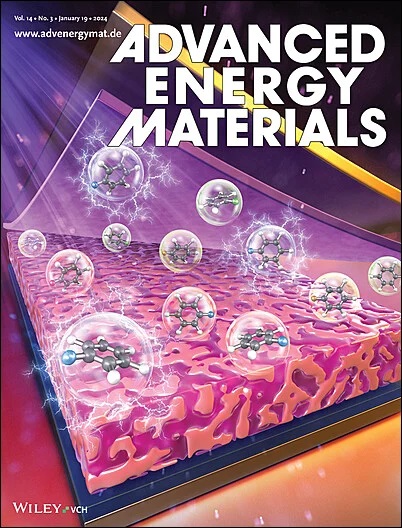破解锂离子电池水溶液中熵-性能关系
IF 24.4
1区 材料科学
Q1 CHEMISTRY, PHYSICAL
引用次数: 0
摘要
开发水性低温电解质符合社会对极端气候和环境下锂电池的需求。然而,主要的挑战包括热力学冰点高、离子扩散慢以及低温下界面不稳定,从而导致能量密度低和循环性能差。本文探讨了混合熵 ΔSmix、氢键和静电相互作用在实现最佳电解质成分中的作用。通过系统地改变醋酸乙酯(EA)/H2O 的比例,在摩尔比为 3.91 时找到了一个临界的 "混合熵最佳点",在这个点上,电解质在分子无序性和界面稳定性之间达到了最佳平衡。在这个最佳点上,带有极性酯基(-COO-)的 EA 分子能有效地打破水的氢键网络,增强 ΔSmix 并将凝固点降至 -106.95 °C。此外,由熵驱动的溶解结构所产生的稳定的界面化学性质有效地抑制了氢的演化,并将电化学窗口扩大到 6.2 V。采用 LiMn2O4-Li4Ti5O12 全电池的全水性锂离子电池在 10 C 的快速速率下循环 1000 次,初始放电比容量为 135.1 mAh g-1。这些结果为设计高性能水基电解质奠定了良好的热力学基础,对下一代低温水基锂离子电池具有重要意义。本文章由计算机程序翻译,如有差异,请以英文原文为准。

Decoding the Entropy-Performance Relationship in Aqueous Electrolytes for Lithium-Ion Batteries
Developing aqueous low-temperature electrolytes aligns with the societal demand for lithium batteries in extreme climates and environments. However, the main challenges include high thermodynamic freezing points, slow ion diffusion, and instability at the interface under low temperatures, resulting in low energy density and poor cycle performance. Here, the role of mixing entropy ΔSmix, hydrogen bonding, and electrostatic interactions in achieving an optimal electrolyte composition is explored. By systematically varying the ethyl acetate (EA)/H2O ratio, a critical “mixing entropy optimal point” at a molar ratio of 3.91, where the electrolyte exhibits the best balance between molecular disorder and interfacial stability is identified. At this optimal point, EA molecules with polar ester group (-COO-) effectively break the hydrogen-bond network of water, enhancing the ΔSmix and lowering the freezing point to −106.95 °C. Furthermore, the stable interfacial chemistry derived from entropy-driven solvation structure effectively suppress hydrogen evolution and expand the electrochemical window to 6.2 V. Full aqueous Li-ion batteries with LiMn2O4-Li4Ti5O12 full cell delivered an initial discharge specific capacity of 135.1 mAh g−1 for 1000 cycles under rapid 10 C rate. The results provide a promising thermodynamic foundation for designing high-performance aqueous electrolytes, with implications for next-generation low-temperature aqueous lithium-ion batteries.
求助全文
通过发布文献求助,成功后即可免费获取论文全文。
去求助
来源期刊

Advanced Energy Materials
CHEMISTRY, PHYSICAL-ENERGY & FUELS
CiteScore
41.90
自引率
4.00%
发文量
889
审稿时长
1.4 months
期刊介绍:
Established in 2011, Advanced Energy Materials is an international, interdisciplinary, English-language journal that focuses on materials used in energy harvesting, conversion, and storage. It is regarded as a top-quality journal alongside Advanced Materials, Advanced Functional Materials, and Small.
With a 2022 Impact Factor of 27.8, Advanced Energy Materials is considered a prime source for the best energy-related research. The journal covers a wide range of topics in energy-related research, including organic and inorganic photovoltaics, batteries and supercapacitors, fuel cells, hydrogen generation and storage, thermoelectrics, water splitting and photocatalysis, solar fuels and thermosolar power, magnetocalorics, and piezoelectronics.
The readership of Advanced Energy Materials includes materials scientists, chemists, physicists, and engineers in both academia and industry. The journal is indexed in various databases and collections, such as Advanced Technologies & Aerospace Database, FIZ Karlsruhe, INSPEC (IET), Science Citation Index Expanded, Technology Collection, and Web of Science, among others.
 求助内容:
求助内容: 应助结果提醒方式:
应助结果提醒方式:


